Explore Rinpung Dzong A Bhutan’s Majestic Fortress In Paro Valley To Embark In 2026
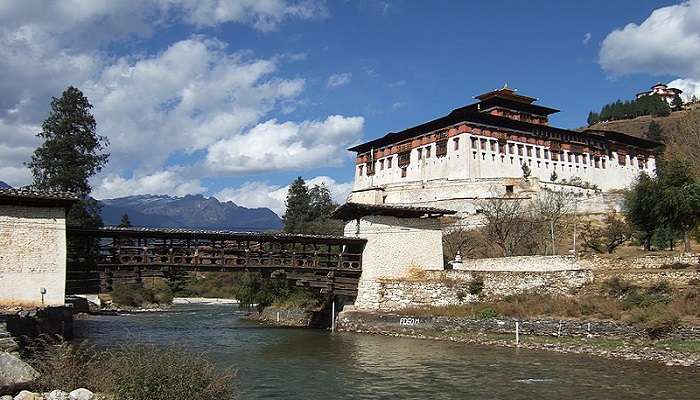
Nestled in the Himalayas, Bhutan is a magical land known for its pristine beauty, breathtaking mountainscapes and deep religious connection to Buddhism. Dotting the country are various dzongs and massive fortresses that blend history and culture. One such marvel is Rinpung Dzong, literally translating to “Fortress on a Heap of Jewels,” in Paro Valley. This stunning architectural marvel, built in the 17th century, served as a crucial defence against many Tibetan invasions. In this blog, let’s get into the details of Rinpung dzong, which is not only a historical landmark but also the heart of Paro in Bhutan.
Rinpung Dzong History
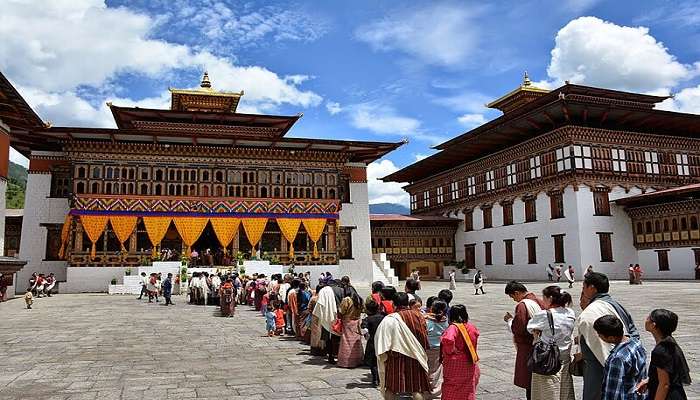
Before the Rinpung Dzong was constructed, a small temple was founded on the same site by Drung Drung Gyal in the 15th century. He was a Llama and a descendant of Phajo Drugom Zhigpo. The temple was later built as a fortress, which came to be recognised as Hungrel Dzong. In 1644, after it was offered to Ngawang Namgyal, he demolished the existing dzong and started constructing a new one known as Rinpung Dzong. The dzong served as a shelter for the Paro residents during Tibetan invasions. It was used as a watchtower, and attacks were targeted only at the fortress. The dzong also used to be the official meeting hall for the National Assembly before it housed administration offices.
Must Read: Bhutan Hill Stations
Rinpung Dzong Architecture

Rinpung Dzong, Paro Dzong, is an extraordinary example of fine Bhutanese architecture. It is known for its ancient Buddhist artefacts and shrines. The Watchtower of the dzong is considered one of the most beautiful, with intriguing woodwork and carvings. It is a seven-storey tower, which is primarily the Paro Dzong. Inside the complex, there are 14 shrines and chapels dedicated to various god figures, including Amitabha Buddha and Avalokiteshvara. It also includes a monk assembly hall.
Rinpung Dzong is built on a cliff overlooking the Paroo River. Like the other buildings in Bhutan, it was not constructed using steel or iron nails. The inner courtyard is colourful and vibrant. The central tower, Utse, is five stories high and imprinted with beautiful religious figures. Half of the dzong is used for religious purposes, while the other half is used as an administration building.
Paro Tshechu Festival At Rinpung Dzong
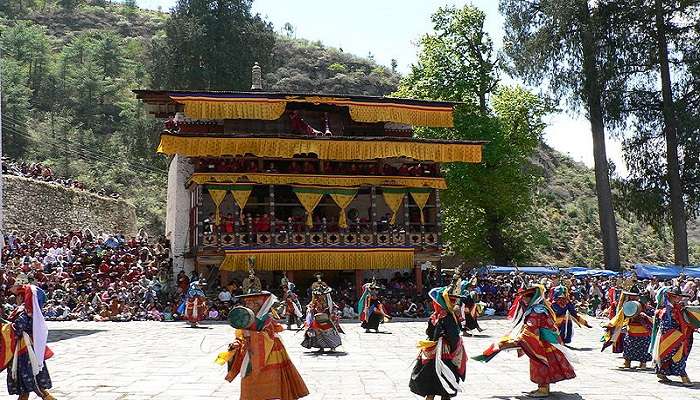
Rinpung Dzong is also the venue for the Paro Valley’s annual springtime religious festival, Paro Tshechu. Paro Tshechu is one of the most popular festivals in Bhutan for locals and tourists alike. The Paro Tshechu is held annually from the 9th till the 15th day of the 2nd month in the Bhutanese lunar calendar, which usually falls in March or April. Masked dance performances by monks in honour of Padmasambhava or Guru Rinpoche are the main highlights of this festival. On the festival’s conclusion day, the unfurling of thongdrol, a sizable Buddhist scroll depicting the Eight Manifestations of Padmasambhava, is displayed for the public in the early morning.
Suggested Read: Bhutan Travel Experience
Places To Visit Near Rinpung Dzong
Beyond exploring the historic Rinpung Dzong, numerous noteworthy attractions exist in and around Paro. While Tiger’s Nest Monastery (Paro Taktsang) offers a stunning cliffside retreat, the National Museum of Bhutan provides rich cultural insights. Here are some of the best places to visit near Rinpung Dzong.
1. National Museum Of Bhutan

The National Museum of Bhutan, a six-storeyed building in Paro, is the pride of Bhutan and is a treasure trove of artefacts as old as 1500 years. Established in 1968 and housed within Paro’s historic Ta-dzong fortress, this museum boasts over 3000 artefacts, including stamps, exquisite bronze statues, intricate thangka paintings, and prehistoric objects. A history enthusiast or an art lover, this museum provides a glimpse into the soul of Bhutan. Renovated in 2016 after the 2011 earthquake, the museum was built to withstand natural disasters and protect the integrity of the building and the artefacts.
Distance from Rinpung Dzong: 1.2 km approx.
Entrance Fee: 300 Nu (3.6 USD)
Operating hours: 9.00 am – 5.00 pm for Summers/ 9.00 am – 4.00 pm for Winter months.
2. Tiger’s Nest Monastery (Paro Taktsang)
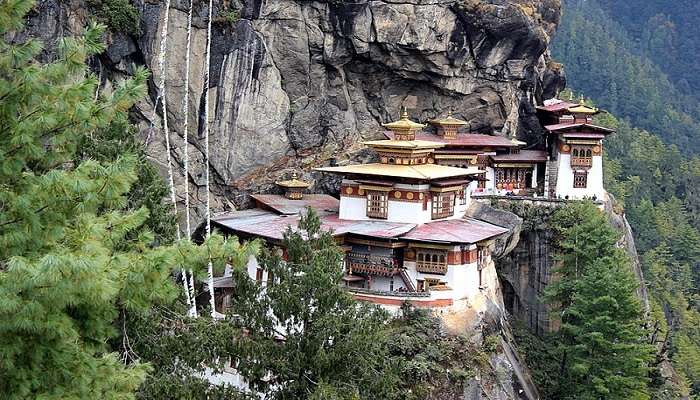
Connected to Tibetan Buddhism, Bhutan’s Tiger’s Nest Monastery, 3000 m above the Paro Valley, is also called Paro Taktsang. According to a legend, Buddhist master Guru Rinpoche, also known as Padmasambhava, arrived from Tibet on a tigress’ back, meditated in one of the caves, and emerged in eight incarnated forms (manifestations), and the place became holy. Subsequently, when a monastery was built around the caves, the place became famous as Tiger’s Nest. This architectural marvel, built in the 1600s, comprises four main temples and residential buildings clinging to the rock face.
Distance from Rinpung Dzong: 2.6 km approx.
Entrance Fee: 1000 Nu (12 USD)
Operating hours: 8:00 am – 1:00 pm, 2:00 pm – 6:00 pm
Suggested Read: Backpacking In Bhutan
3. Chelela Pass
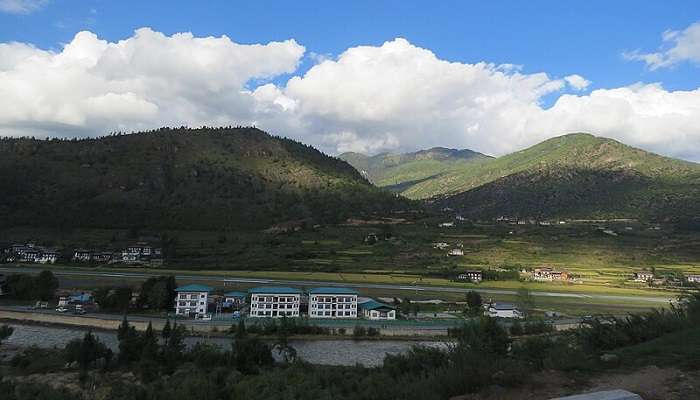
Chelela Pass, a haven for nature lovers and hiking enthusiasts, is Bhutan’s highest motorable road. This majestic pass, carved through dramatic mountains, connects the picturesque Paro and Haa valleys. Drive through the narrow winding roads offering a glimpse of stunning valleys and snow-covered peaks like Mt. Jomolhari. Indulge in the splendid views at the summit, unfolding a breathtaking panorama with a rich biodiversity of the surrounding area. Hikers can explore ancient trails and untouched forests thriving with flora and fauna and bask in the crisp mountain air. Enjoy the taste of Bhutan’s captivating scenery and its thrilling mountain passes.
Distance from Rinpung Dzong: 41 km approx.
Entrance Fee: None
Operating hours: 24 x 7
4. Tachog Lhakhang Bridge
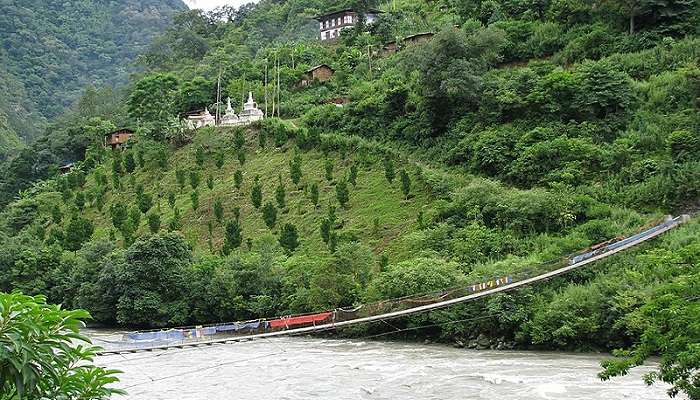
Tachog Lhakhang, which translates to “Temple of the Hill of the Excellent Horse”, is one of the most scenic places to visit in Paro, Bhutan. A 600-year-old bridge was built by the legendary Tibetan architect, physician and civil engineer Thangtong Gyalpo, fondly called Iron Bridge builder in the late 1300s. While on his trip to Paro, Bhutan, it is believed that he had a vision of a spiritual horse while meditating along the Paroo River that inspired him to build a temple and his famous iron bridge that crosses the Paro Chhu. Built of wood and Iron, this is the first bridge in Bhutan.
Distance from Rinpung Dzong: 20.5 km approx.
Entrance Fee: None
Operating hours: 24 x 7
Suggested Read: Bhutan Travel Tips
How To Reach Rinpung Dzong Bhutan
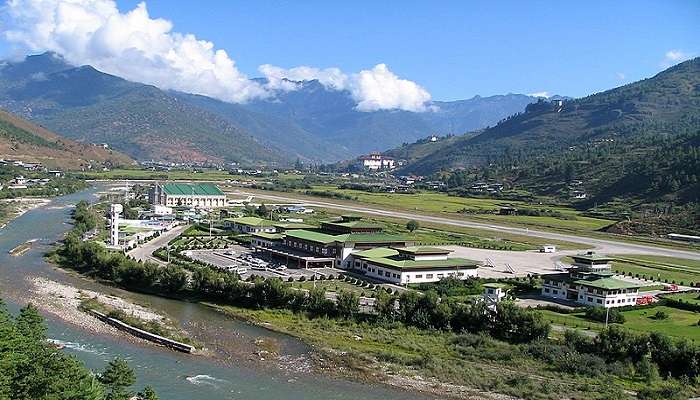
Bhutan enjoys decent air connectivity with a few Asian countries, including India, Bangladesh, Nepal, and Thailand. Fly to Paro International Airport at Paro and Rinpung Dzong, located around 6 km from Paro International Airport, Bhutan. Set off on a scenic journey through lush forests and enjoy the splendid views of the Paro Valley.
Further Read: Bhutan Villages
Whether you’re on a quest to visit Bhutan’s best architectural marvel or want to align with your higher self spiritually, Rinpung Dzong Paro is the destination. The region accommodates everything from the trekking trails of Tiger’s Nest Monastery to the awe-inspiring views from Chelela Pass and the vibrant Paro Tshechu festival. Hopefully, this comprehensive guide will motivate you to plan a trip to Bhutan with your friends and family!
For our editorial codes of conduct and copyright disclaimer, please click here.
Cover Image Credit: Christopher Fynn for Wikimedia Common
Frequently Asked Questions About Rinpung Dzong
What are Rinpung Dzong timings?
Rinpung Dzong's opening hours are from 9:00 a.m. to 5:00 p.m., making it convenient for all visitors to visit and explore the place.
How much is the Rinpung Dzong entry fee?
There is no entry fee for visiting the Rinpung Dzong. However, charges are applicable if you see the dzong with a guide.
Is photography allowed at Rinpung Dzong?
Photography /filming within Rinpung Dzong premises is not allowed. However, the outer premises and courtyards can be filmed or photographed. Before taking pictures or videos, it is advisable to seek permission at dzongs, monasteries, temples, or other religious institutions.
Is there any dress code while visiting dzongs or monasteries?
A modest dress code is recommended. Clothing covering arms and legs is a must. Also, be respectful of local traditions.
What are the activities that can be done in Paro, Bhutan?
A few things to do in Bhutan include hiking, trekking, biking trails, camping at Bumdra, river rafting at Paro, shopping at the Paro Craft market, and attending vibrant festivals.
People Also Read:
Kumbhalgarh Fort Shergarh Fort Mehrangarh Fort

Unveil the hidden treasures of the globe and turn every travel dream into reality. As a Content Writer, I am passionate enough to craft stories from ancient wonders to modern marvels. My words paint the picture-perfect itinerary for unforgettable experiences. Let my words be your trusted guide to immerse in the diverse culture and discover the beauty of the unknown.











